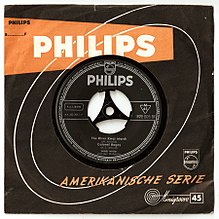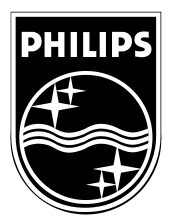Philips Phonographic Industry
Philips Phonographische Industrie NV was the first subsidiary of the Philips group for vinyl recordings.
history
Electric turntables began to appear on the market in the 1930s , and most manufacturers of these devices also sold their own records. At Philips, they waited for the LP to be introduced in 1947 before considering starting their own. This product was considered to be far superior to shellac records and marketable, an assessment that was soon to be confirmed. Philips founded its production company on September 28, 1950 in Baarn near the Dutch broadcasting center in Hilversum . A record factory was built there by 1951. The catalog of popular music initially consisted essentially of productions by the Dutch division of Decca Records . For serious music , however, separate recordings should be made, which initially turned out to be a difficult undertaking, as all known artists already had contracts with established labels. Jaap van Ginneken, a radio producer, and Us van der Meulen, who had already recorded Willem Mengelberg's legendary St. Matthew Passion on Philips Miller film in 1939, were won as producers .
The first recordings took place in December 1950 with the lesser-known Willem van Otterloo and the Residentie Orkest Den Haag . Since there was no hall with good acoustics in either Baarn or The Hague, the Concertgebouw in Amsterdam was chosen as the recording location . In January 1951, the Concertgebouw Orchestra could also be recorded for the first time ; Paul van Kempen conducted Tchaikovsky's 1812 Overture , which is also a fitting work for a premiere. In the course of the year the symphonies 5 and 6 as well as Romeo and Juliet were added with the same cast .
In 1952 Antal Doráti and Eugen Jochum could be hired for recordings with the Concertgebouw Orchestra, in 1953 Jean Fournet with French orchestras and in 1954 Eduard van Beinum from Decca. Other well-known artists who joined Philips in the 1950s included Clara Haskil , Arthur Grumiaux and I Musici . In 1955 they recorded a work that was almost unknown at the time for Philips: Vivaldi's Four Seasons . With the Philips series Monumenta Italicae Musicae under the direction of the musicologist Vittorio Negri , the revival of Italian baroque music began . In 1959 the four seasons were re-recorded with the same line-up, this time in stereo . This recording has remained almost consistently in the catalog to this day.

The classic catalog of the Philips label grew rapidly, from 38 records in 1952 to 107 copies in 1953, 283 copies in 1955 to 680 productions in 1956. However, these figures also include licensed recordings from Columbia Records from 1951, which were neither distributed nor produced until 1961 owned for Europe. This enabled Philips to publish recordings by American star artists such as Eugene Ormandy , Bruno Walter and Rudolf Serkin . A similar matrix exchange existed with the Mercury Records label , which had developed the highly successful Mercury Living Presence recording system. Mercury recordings were released in Europe on the Philips label, Philips recordings in the USA on the Mercury label. The Living Presence recording process was used in the 1960s and further developed; later they took over Mercury entirely.
In 1961 Sir Colin Davis was hired , who started his Berlioz complete recording of orchestral and stage works with Les Troyens . In 1963 Bernard Haitink began his cycle of all Bruckner symphonies. In 1969, new producer Erik Smith brought Neville Marriner and the Academy of St. Martin in the Fields to Decca, as well as Alfred Brendel .
In 1962 Philips brought the Philips Phonographic Industry together with the Deutsche Grammophon Gesellschaft , which Siemens brought in, into the Gramophon Philips Group . Siemens received 50% in Philips Phonographische Industrie through a share swap , and in return Philips received 50% in DGG. In 1967 the Philips Phonographic Industry was renamed Phonogram International , in 1972 the group merged to PolyGram . The Philips label is still used by their successor companies today.
